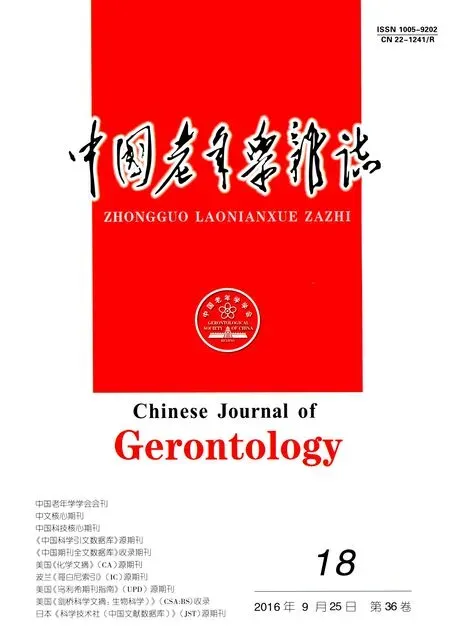内生致热原3受体在发热中的研究进展
孟庆超 张 量
(沈阳医学院基础医学院生理学教研室,辽宁 沈阳 110034)
内生致热原3受体在发热中的研究进展
孟庆超张量
(沈阳医学院基础医学院生理学教研室,辽宁沈阳110034)
前列腺素E2;内生致热原(EP)3受体;发热;体温调节
发热是由于发热激活物作用于机体,导致内生致热原(EP)产生,入脑作用于体温调节中枢,继而引起发热中枢介质的释放和体温调定点的改变,最终引起发热。前列腺素(PG)E2是人体内广泛存在的前列腺素类物质。PGE2是一种小分子物质,能透过血脑屏障,刺激下丘脑前部和脑干负责体温调节的神经元,进而引发体温变化。其调节体温功能是通过与其EP受体结合后的信号转导途径实现的。EP受体已鉴定有4种亚型:EP1、EP2、EP3和EP4,其中EP3受体的表达变化和信号转导途径与发热关系密切,是目前该领域研究热点之一。
1 EP3受体的分子特性
EP受体属 G蛋白耦联受体超家族,具有7次跨膜的疏水α-螺旋、 胞外的c-末端及胞内的N-末端3个结构域 。目前已知PGE2受体有4个亚型分别为:EP1、EP2、EP3、EP4。其中编码EP3受体的基因在转录过程中产生多种mRNA剪接变体。剪接变体的差异导致胞外c-末端氨基酸序列改变,人类编码EP3受体的基因在转录过程中可产生9种不同mRNA来编码8种不同的EP3受体亚型,如EP3-Ⅰ、EP3-Ⅱ、EP3-Ⅲ、EP3-Ⅳ、EP3-Ⅴ和EP3-Ⅵ等,人肾脏、胰腺和子宫EP3mRNA表达最丰富,在心脏、肝脏、骨骼肌、小肠、结肠、前列腺、卵巢和睾丸中也有表达〔1,2〕。Vasilache等〔3〕应用实时荧光聚合酶链反应(PCR)分析显示,在小鼠下丘脑体温调节中枢中主要表达EP3α,EP3γ大约占总EP3受体的15%,EP3β少量表达。
2 EP3信号转导通路的研究
EP3受体与多种病理生理反应有着密切联系,如体温调节、肿瘤生长和血压调节等。不同的EP3异构体可以和不同的G蛋白耦联,在EP3受体激动剂诱导下,引起细胞内第二信使浓度变化,激活相应的靶酶,发挥作用〔4~6〕。EP3受体可与Gq、Gi和Gs蛋白耦联,胞内主要效应表现为钙离子(Ca2+)、三磷酸肌醇(IP3)水平升高和环磷酸腺苷(cAMP)水平降低〔7,8〕。Israel等〔9〕应用免疫印迹分析表明nmol浓度的PGE2可通过EP3-Ⅱ和EP3-Ⅲ亚型强烈激活细胞外信号调节激酶(ERK 1/2)使之磷酸化,而EP3-Ⅰa 亚型作用是最小的,只发生在μmol浓度PGE2;PGE2通过EP3-Ⅲ受体亚型激活的ERK 1/2磷酸化的途径包括Galpha(i)/磷脂酰肌醇3-激酶(PI3K)/蛋白激酶(PK)C/Src和表皮生长因子受体(EGFR)依赖途径,而通过EP3-Ⅱ受体亚型激活ERK 1/2的磷酸化的途径包括Galpha(i)/Src和EGFR依赖途径。
3 EP3与发热的关系
PGE2是重要的中枢性体温正调节介质之一,发热时下丘脑体温调节中枢内的PGE2含量及其受体的表达均增高。脑室注射及静脉注射白细胞介素(IL)-1β,静脉注射大剂量脂多糖(LPS)均是通过诱导中枢PGE2的合成增加而引起发热,且小鼠实验中PGE2只有作用于EP3后才引起发热效应〔10〕。应用EP1、EP2和EP3受体激动剂注射猪脑室发现,EP2、EP3和EP2/EP3受体激动剂均可以导致猪体温升高,其中EP3受体激动剂作用最为显著,而EP1受体激动剂未能引起发热〔11〕。Oka等〔12,13〕应用基因敲除小鼠进行实验,结果发现脑室内注射EP1和EP3受体激动剂均可引起发热效应,而EP4受体激动剂却能抑制发热效应,并且视前区(POA)单独注射EP1受体激动剂只引起了痛觉过敏而不是高热。有研究显示EP1和EP3受体参与了系统性炎症引起的发热,没有参与中心体温(Tc)生理升高或心理应激引起的体温升高〔14〕。由于动物种属差异,文献之间关于EP受体引起发热还存在分歧。
4 EP3对体温调节的作用
目前大多数文献提示EP3介导发热的可能性较大,许多学者针对EP3受体做了研究。Nakayama等〔15,16〕首先发现热敏神经元在POA,并发现神经元自发放电频率增加期间,下丘脑温度升高。PGE2是发热的主要介质,其中EP3受体介导PGE2引起发热。在POA特定区域的神经元胞体和树突上表达了大量的EP3受体分别是:正中视前核(MnPO)和内侧视前区(MPO)〔17,18〕。该区域的EP3受体亚群的信号直接投射到下丘脑背内侧核(DMH)或延髓中缝苍白球(rRPa),并发现投射到DMH区域的神经元是γ-氨基丁酸(GABA)能的〔19,20〕。GABA(A)受体拮抗剂或GABA(A)受体表达下降在DMH或rRPa引发发热反应,包括棕色脂肪组织(BAT)产热和心动过速〔21~24〕。PGE2与EP3受体结合后G蛋白与EP3受体发生耦联使cAMP水平降低。脑室内注射PGE2导致POA内cAMP水平降低,而应用cAMP降解酶抑制剂(磷酸二酯酶抑制剂)可使发热反应减弱〔25〕。这些结果表明,表达有EP3受体的POA神经元有可能通过与PGE2结合,抑制在DMH或rRPa的GABA能产热神经元,并使POA内的cAMP水平下降,从而引起发热反应。另外,α(1)-肾上腺素能受体介导体温过低反应,同PGE2介导的发热反应相反〔26〕。李沧海等〔27〕给大鼠脑室注射EP3受体激动剂硫前列酮和同等量的PGE2发现均可使大鼠体温升高并呈剂量关系;分别和同时给予磷酯酰肌醇特异性磷酯酶C(PI-PLC)和Ca2+/ 钙调蛋白依赖性蛋白激酶Ⅱ(CaMKⅡ)抑制剂(KN-62),新霉素(Neo)和KN-62均可抑制硫前列酮和PGE2的升温作用,其中Neo比较显著;Neo可使IP3和二酰甘油(DG)生成减少,影响IP3-Ca2+和DG-PKC通路,说明PI-PLC-IP3-Ca2+参与了发热机制;同样,KN-62是CaMKⅡ特异性抑制剂说明CaMKⅡ参与了发热机制。这些结果提示PGE2可能主要通过EP3受体诱导大鼠发热,其胞内环节可能与PI-PLC-IP3-Ca2+/CaM-CaMKⅡ通路有关〔27〕。
5 EP3受体的应用与展望
目前研究发现表达在小鼠眼角膜上的EP3受体对眼表炎症有很好的抑制作用,由于在人眼表也表达有EP3受体,这结果提示了一种新的治疗眼角膜疾病的方法〔28〕。有学者提出前列腺素EP3受体抑制剂与新抗血小板聚集药不但可以有效抑制血小板的聚集,而且不会延长出血时间〔29〕。另外,在血压和癌症等疾病中也已经有许多的文献提出了新的思路。EP3受体参与了多种生物功能,也与许多疾病密切相关,但是许多机制尚待后续的研究。针对EP3受体的研究可以了解疾病的发生和发展,如:高血压、癌症和炎症等。特别是选择性的以EP3受体为靶受体的,为疾病的治疗提供新的方案可能。
1Kotani M,Tanaka I,Ogawa Y,etal.Structural organization of the human prostaglandin EP3 receptor subtype gene(PTGER3)〔J〕.Genomics,1997;40(3):425-34.
2Kotani M,Tanaka I,Ogawa Y,etal.Molecular cloning and expression of multiple isoforms of human prostaglandin E receptor EP3 subtype generated by alternative messenger RNA splicing:multiple second messenger systems and tissue-specific distributions〔J〕.Mol Pharmacol,1995;48(5):869-79.
3Vasilache AM,Andersson J,Nilsberth C.Expression of PGE2 EP3 receptor subtypes in the mouse preoptic region〔J〕.Neurosci Lett,2007;423(3):179-83.
4Schmid A,Thierauch KH,Schleuning WD,etal.Splice variants of the human EP3 receptor for prostaglandin E2〔J〕.Eur J Biochem,1995;228(1):23-30.
5Bilson HA,Mitchell DL,Ashby B.Human prostaglandin EP3 receptor isoforms show different agonist-induced internalization patterns〔J〕.FEBS Lett,2004;572(1-3):271-5.
6An S,Yang J,So SW,etal.Isoforms of the EP3 subtype of human prostaglandin E2 receptor transduce both intracellular calcium and cAMP signals〔J〕.Biochemistry,1994;33(48):14496-502.
7Irie A,Sugimoto Y,Namba T,etal.Third isoform of the prostaglandin-E-receptor EP3 subtype with different C-terminal tail coupling to both stimulation and inhibition of adenylate cyclase〔J〕.Eur J Biochem,1993;217(1):313-8.
8Narumiya S,Sugimoto Y,Ushikubi F.Prostanoid receptors:structure,propertyes,and functions〔J〕.Physiol Rev,1999;79(4):1193-226.
9Israel DD,Regan JW.EP(3) prostanoid receptor isoforms utilize distinct mechanisms to regulate ERK 1/2 activation〔J〕.Biochim Biophys Acta,2009;1791(4):238-45.
10Ushikubi F,Segi E,Sugimoto Y,etal.Impaired febrile response in mice lacking the prostaglandin E receptor subtype EP3〔J〕.Nature,1998;395(6699):281-4.
11Parrott RF,Vellucci SV.Effects of centrally administered prostaglandin EP receptor agonists on febrile and adrenocortical responses in the prepubertal pig〔J〕.Brain Res Bull,1996;41(2):97-103.
12Oka T,Oka K,Saper CB.Contrasting effects of E type prostaglandin (EP) receptor agonists on core body temperature in rats〔J〕.Brain Res,2003;968(2):256-62.
13Oka T.Prostaglandin E2 as a mediator of fever:the role of prostaglandin E (EP) receptors〔J〕.Front Biosci,2004;9:3046-57.
14Oka T,Oka K,Kobayashi T,etal.Characteristics of thermoregulatory and febrile responses in mice deficient in prostaglandin EP1 and EP3 receptors〔J〕.J Physiol,2003;551(Pt 3):945-54.
15Nakayama T,Eisenman JS,Hardy JD.Single unit activity of anterior hypothalamus during local heating〔J〕.Science,1961;134(3478):560-1.
16Boulant JA,Hardy JD.The effect of spinal and skin temperatures on the firing rate and thermosensitivity of preoptic neurones〔J〕.J Physiol,1974;240(3):639-60.
17Nakamura K,Kaneko T,Yamashita Y,etal.Immunocytochemical localization of prostaglandin EP3 receptor in the rat hypothalamus〔J〕.Neurosci Lett,1999;260(2):117-20.
18Nakamura K,Kaneko T,Yamashita Y,etal.Immunohistochemical localization of prostaglandin EP3 receptor in the rat nervous system〔J〕.J Comp Neurol,2000;421(4):543-69.
19Nakamura K,Matsumura K,Kaneko T,etal.The rostral raphe pallidus nucleus mediates pyrogenic transmission from the preoptic area〔J〕.J Neurosci,2002;22(11):4600-10.
20Nakamura Y,Nakamura K,Matsumura K,etal.Direct pyrogenic input from prostaglandin EP3 receptor-expressing preoptic neurons to the dorsomedial hypothalamus〔J〕.Eur J Neurosci,2005;22(12):3137-46.
21Cao WH,Fan W,Morrison SF.Medullary pathways mediating specific sympathetic responses to activation of dorsomedial hypothalamus〔J〕.Neuroscience,2004;126(1):229-40.
22Zaretskaia MV,Zaretsky DV,Shekhar A,etal.Chemical stimulation of the dorsomedial hypothalamus evokes non-shivering thermogenesis in anesthetized rats〔J〕.Brain Res,2002;928(1-2):113-25.
23Nakamura Y,Nakamura K,Morrison SF.Different populations of prostaglandin EP3 receptor-expressing preoptic neurons project to two fever-mediating sympathoexcitatory brain regions〔J〕.Neuroscience,2009;161(2):614-20.
24Tsuchiya H,Oka T,Nakamura K,etal.Prostaglandin E2 attenuates preoptic expression of GABAA receptors via EP3 receptors〔J〕.J Biol Chem,2008;283(16):11064-71.
25Steiner AA,Antunes-Rodrigues J,Branco LG.Role of preoptic second messenger systems (cAMP and cGMP) in the febrile response〔J〕.Brain Res,2002;944(1-2):135-45.
26Osaka T.Heat loss responses and blockade of prostaglandin E2-induced thermogenesis elicited by alpha1-adrenergic activation in the rostromedial preoptic area〔J〕.Neuroscience,2009;162(4):1420-8.
27李沧海,周军,霍海如,等.前列腺素EP3受体激动剂诱导发热及其机制初探〔J〕.中国病理生理杂志,2004;20(4):664-5,672.
28Kinoshita S.Research and development for treating devastating corneal diseases〔J〕.Nihon Ganka Gakkai Zasshi,2010;114(3):161-99.
29王晓锋,陈乃宏,王文,等.抗血小板聚集药物的机制研究进展〔J〕.中国康复理论与实践,2010;16(10):954-7.
〔2015-05-26修回〕
(编辑王一涵)
国家和辽宁省大学生创新创业训练计划项目(No.201310164005);沈阳市科技局科技计划项目(No.F13-221-9-49)
张量(1970-),女,教授,硕士生导师,主要从事神经细胞损伤与中枢源性发热治疗研究。
孟庆超(1992-),男,主要从事神经细胞损伤与中枢源性发热治疗研究。
R364.6
A
1005-9202(2016)18-4650-03;doi:10.3969/j.issn.1005-9202.2016.18.122

